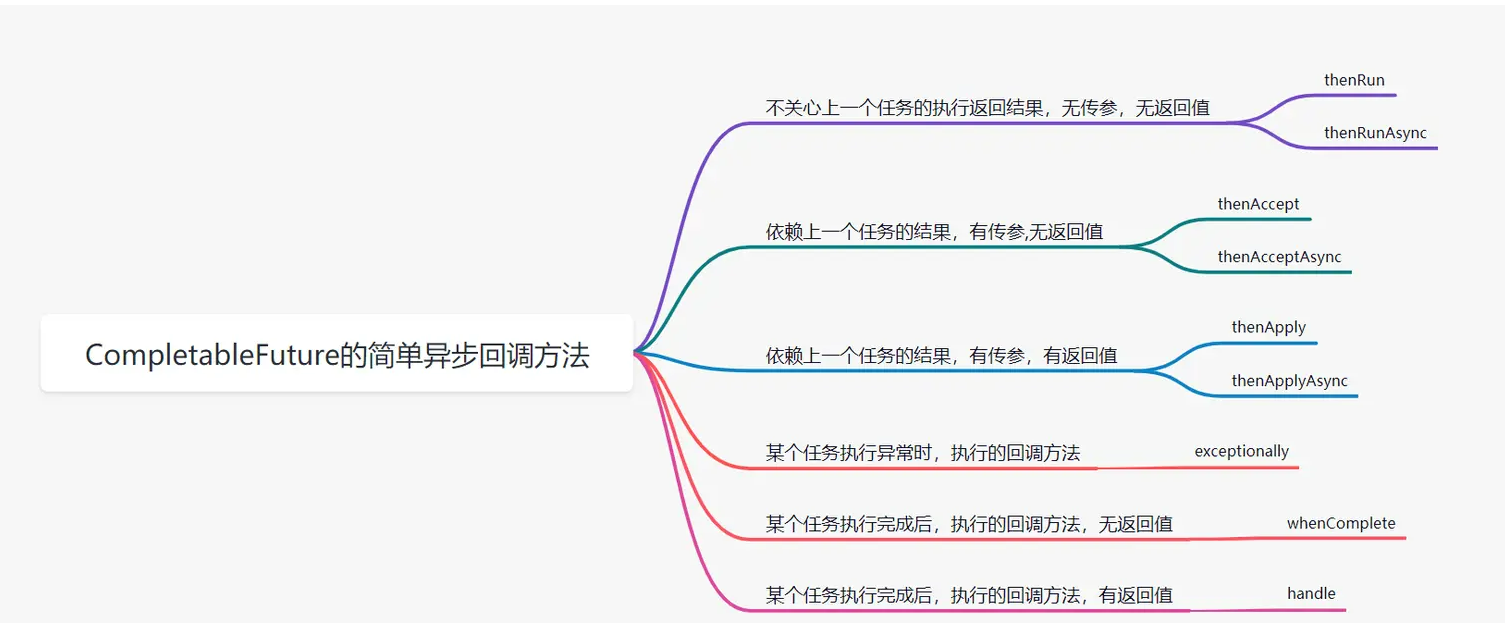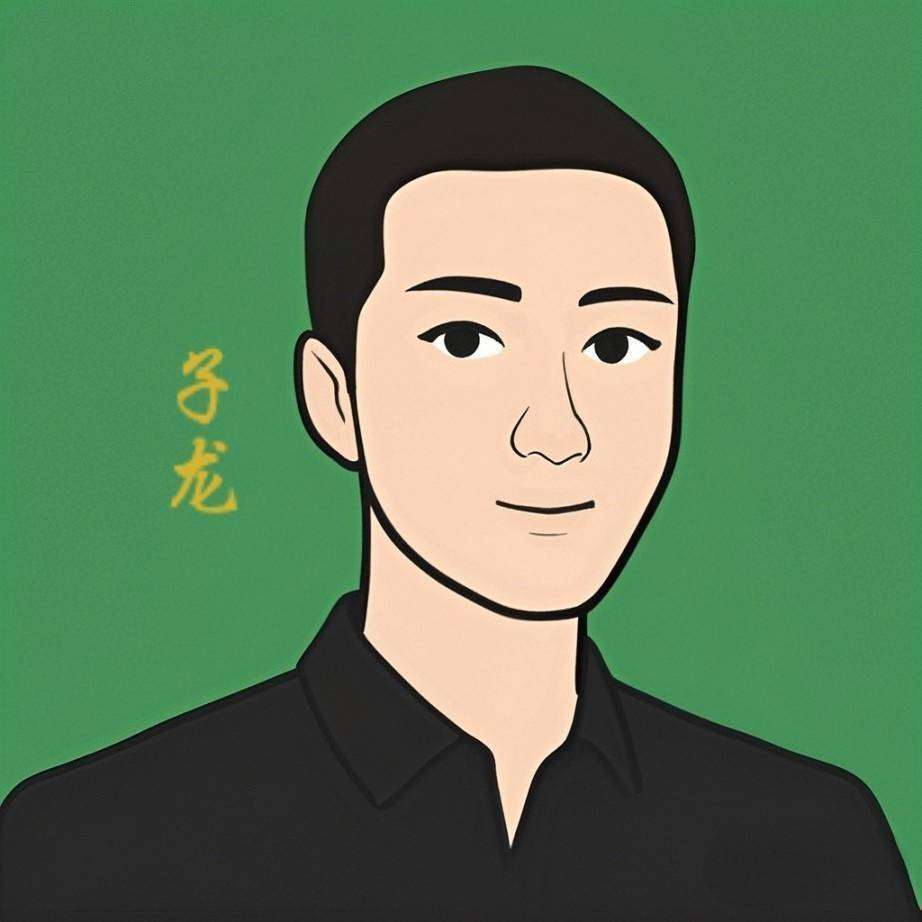 异步编程神器:CompletableFuture详解
异步编程神器:CompletableFuture详解
使用Future获得异步执行结果时,要么调用阻塞方法get(),要么轮询看isDone()是否为true,这两种方法都不是很好,因为主线程也会被迫等待。
从Java 8开始引入了CompletableFuture,它针对Future做了改进,可以传入回调对象,当异步任务完成或者发生异常时,自动调用回调对象的回调方法。
CompletableFuture 使用场景:创建异步任务、任务异步回调、多个任务组合处理。
# 创建异步任务
- supplyAsync supplyAsync是创建带有返回值的异步任务。它有两个方法,一个是使用默认线程池(ForkJoinPool.commonPool())的方法,一个是带有自定义线程池的重载方法。
没有指定Executor的方法会使用ForkJoinPool.commonPool() 作为它的线程池执行异步代码。如果指定线程池,则使用指定的线程池运行。如果所有 CompletableFuture 共享一个线程池,那么一旦有任务执行一些很慢的 I/O 操作,就会导致线程池中所有线程都阻塞在 I/O 操作上,从而造成线程饥饿,进而影响整个系统的性能。所以,强烈建议要根据不同的业务类型创建不同的线程池,以避免互相干扰
// 带返回值异步请求,默认线程池ForkJoinPool.commonPool
public static <U> CompletableFuture<U> supplyAsync(Supplier<U> supplier)
// 带返回值的异步请求,可以自定义线程池
public static <U> CompletableFuture<U> supplyAsync(Supplier<U> supplier, Executor executor)
2
3
4
5
使用默认线程池:
CompletableFuture<String> cf = CompletableFuture.supplyAsync(() -> {
System.out.println("业务代码");
return "result";
});
//等待任务执行完成
System.out.println("结果->" + cf.get());
2
3
4
5
6
7
8
使用自定义线程池:
ThreadPoolExecutor threadPoolExecutor = new ThreadPoolExecutor(10,10,10,TimeUnit.SECONDS, new ArrayBlockingQueue<>(100));
long startTime = System.currentTimeMillis();
List<User> userList = new ArrayList<>();
for (int i = 0; i < 10; i++) {
CompletableFuture<User> completableUserInfoFuture = CompletableFuture.supplyAsync(() -> userService.getUser(1), threadPoolExecutor);
try {
User user = completableUserInfoFuture.get();
userList.add(user);
} catch (InterruptedException e) {
e.printStackTrace();
} catch (ExecutionException e) {
e.printStackTrace();
}
}
System.out.println("总共用时" + (System.currentTimeMillis() - startTime) + "ms");
2
3
4
5
6
7
8
9
10
11
12
13
14
15
16
17
18
2、runAsync 方法以Runnable函数式接口类型为参数,没有返回结果。支持默认线程池和自定义线程池。
//使用默认内置线程池ForkJoinPool.commonPool(),根据supplier构建执行任务
public static CompletableFuture<Void> runAsync(Runnable runnable)
public static CompletableFuture<Void> runAsync(Runnable runnable, Executor executor)
2
3
4
ThreadPoolExecutor threadPoolExecutor = new ThreadPoolExecutor(10,10,10,TimeUnit.SECONDS, new ArrayBlockingQueue<>(100));
CompletableFuture.runAsync(() -> userService.getUser(1), threadPoolExecutor);
2
3
4
# 获取结果
join&get
join()和get()方法都是用来获取CompletableFuture异步之后的返回值。join()方法抛出的是uncheck异常(即未经检查的异常),不会强制开发者抛出。get()方法抛出的是经过检查的异常,ExecutionException, InterruptedException 需要用户手动处理(抛出或者 try catch)
# 结果处理

依赖关系:
- thenApply() 把前面异步任务的结果,交给后面的Function
- thenCompose()用来连接两个有依赖关系的任务,结果由第二个任务返回
and聚合关系:
- thenCombine:任务合并,有返回值
- thenAccepetBoth:两个任务执行完成后,将结果交给thenAccepetBoth消耗,无返回值。
- runAfterBoth:两个任务都执行完成后,执行下一步操作(Runnable)。
or聚合关系:
- applyToEither:两个任务谁执行的快,就使用那一个结果,有返回值。
- acceptEither: 两个任务谁执行的快,就消耗那一个结果,无返回值。
- runAfterEither: 任意一个任务执行完成,进行下一步操作(Runnable)。
并行执行:
CompletableFuture类自己也提供了anyOf()和allOf()用于支持多个CompletableFuture并行执行
# whenComplete
当CompletableFuture的计算结果完成,或者抛出异常的时候,我们可以执行特定的 Action。主要是下面的方法:
public CompletableFuture<T> whenComplete(BiConsumer<? super T,? super Throwable> action)
public CompletableFuture<T> whenCompleteAsync(BiConsumer<? super T,? super Throwable> action)
public CompletableFuture<T> whenCompleteAsync(BiConsumer<? super T,? super Throwable> action, Executor executor)
2
3
4
5
- 方法不以Async结尾,意味着Action使用相同的线程执行,而Async可能会使用其它的线程去执行(如果使用相同的线程池,也可能会被同一个线程选中执行)。
- CompletableFuture的whenComplete方法表示,某个任务执行完成后,执行的回调方法,无返回值;并且whenComplete方法返回的CompletableFuture的result是上个任务的结果。
CompletableFuture<String> orgFuture = CompletableFuture.supplyAsync(
()->{
System.out.println("当前线程名称:" + Thread.currentThread().getName());
try {
Thread.sleep(2000L);
} catch (InterruptedException e) {
e.printStackTrace();
}
return "hello";
}
);
CompletableFuture<String> rstFuture = orgFuture.whenComplete((a, throwable) -> {
System.out.println("当前线程名称:" + Thread.currentThread().getName());
System.out.println("上个任务执行完" + a + "传过来");
if ("hello".equals(a)) {
System.out.println("666");
}
System.out.println("1111");
});
System.out.println(rstFuture.get());
//当前线程名称:ForkJoinPool.commonPool-worker-1
//当前线程名称:ForkJoinPool.commonPool-worker-1
//上个任务执行完hello传过来
//666
//1111
//hello
2
3
4
5
6
7
8
9
10
11
12
13
14
15
16
17
18
19
20
21
22
23
24
25
26
27
28
29
# exceptionally
某个任务执行异常时,执行的回调方法;并且有抛出异常作为参数,传递到回调方法。
CompletableFuture<String> future = CompletableFuture.supplyAsync(() -> {
try {
TimeUnit.SECONDS.sleep(1);
} catch (InterruptedException e) {
}
int i = 12 / 0;
System.out.println("执行结束!");
return "test";
});
future.exceptionally(new Function<Throwable, String>() {
@Override
public String apply(Throwable t) {
System.out.println("执行失败:" + t.getMessage());
return "异常xxxx";
}
});
2
3
4
5
6
7
8
9
10
11
12
13
14
15
16
17
18
19
# 结果消费
结果消费系列函数只对结果执行Action,而不返回新的计算值。
根据对结果的处理方式,结果消费函数分为:
- thenAccept系列:对单个结果进行消费
- thenAcceptBoth系列:对两个结果进行消费
- thenRun系列:不关心结果,只对结果执行Action
# thenAccept
public CompletionStage<Void> thenAccept(Consumer<? super T> action);
public CompletionStage<Void> thenAcceptAsync(Consumer<? super T> action);
2
CompletableFuture的thenAccept方法表示,第一个任务执行完成后,执行第二个回调方法任务,会将该任务的执行结果,作为入参,传递到回调方法中,但是回调方法是没有返回值的。
CompletableFuture<Void> future = CompletableFuture
.supplyAsync(() -> {
int number = new Random().nextInt(10);
System.out.println("返回值:" + number);
return number;
}).thenAccept(number ->
System.out.println("第二次计算结果:" + number * 10));
2
3
4
5
6
7
thenAccept和thenAcceptAsync有什么区别呢?可以看下源码:
public CompletableFuture<Void> thenAccept(Consumer<? super T> action) {
return uniAcceptStage(null, action);
}
public CompletableFuture<Void> thenAcceptAsync(Consumer<? super T> action) {
return uniAcceptStage(asyncPool, action);
}
2
3
4
5
6
7
如果执行第一个任务的时候,传入了一个自定义线程池:
- 调用thenAccept方法执行第二个任务时,则第二个任务和第一个任务是共用同一个线程池。
- 调用thenAcceptAsync执行第二个任务时,则第一个任务使用的是你自己传入的线程池,第二个任务使用的是ForkJoin线程池
thenRun 和thenRunAsync,thenApply和thenApplyAsync等,它们之间也是这个区别。
# thenRun
public CompletionStage<Void> thenRun(Runnable action);
public CompletionStage<Void> thenRunAsync(Runnable action);
2
thenRun 会在上一阶段 CompletableFuture 计算完成的时候执行一个Runnable,Runnable并不使用该 CompletableFuture 计算的结果。CompletableFuture的thenRun方法,通俗点讲就是,做完第一个任务后,再做第二个任务。某个任务执行完成后,执行回调方法;但是前后两个任务没有参数传递,第二个任务也没有返回值。
CompletableFuture<String> future = CompletableFuture.supplyAsync(
() -> {
System.out.println("先执行第一个CompletableFuture方法任务");
return "hello";
}
);
CompletableFuture thenRunFuture = future.thenRun(() -> {
System.out.println("执行第二个任务");
});
System.out.println(thenRunFuture.get());
2
3
4
5
6
7
8
9
10
11
12
# 结果转换
将上一段任务的执行结果作为下一阶段任务的入参参与重新计算,产生新的结果。
# thenApply
thenApply 接收一个函数作为参数,使用该函数处理上一个CompletableFuture 调用的结果,并返回一个具有处理结果的Future对象。第一个任务执行完成后,执行第二个回调方法任务,会将该任务的执行结果,作为入参,传递到回调方法中,并且回调方法是有返回值的。
public <U> CompletableFuture<U> thenApply(Function<? super T,? extends U> fn)
public <U> CompletableFuture<U> thenApplyAsync(Function<? super T,? extends U> fn)
2
CompletableFuture<Integer> future = CompletableFuture.supplyAsync(() -> {
int result = 10;
System.out.println("一阶段:" + result);
return result;
}).thenApply(number -> {
int result = number * 3;
System.out.println("二阶段:" + result);
return result;
});
System.out.println(future.get());
2
3
4
5
6
7
8
9
10
11
一阶段:10 二阶段:30 30
# thenCompose
thenCompose方法会在某个任务执行完成后,将该任务的执行结果,作为方法入参,去执行指定的方法。该方法会返回一个新的CompletableFuture实例
- 如果该CompletableFuture实例的result不为null,则返回一个基于该result新的CompletableFuture实例;
- 如果该CompletableFuture实例为null,然后就执行这个新任务
CompletableFuture<Integer> future = CompletableFuture
.supplyAsync(new Supplier<Integer>() {
@Override
public Integer get() {
int number = new Random().nextInt(30);
System.out.println("第一次计算结果:" + number);
return number;
}
})
.thenCompose(new Function<Integer, CompletionStage<Integer>>() {
@Override
public CompletionStage<Integer> apply(Integer param) {
return CompletableFuture.supplyAsync(new Supplier<Integer>() {
@Override
public Integer get() {
int number = param * 2;
System.out.println("第二次计算结果:" + number);
return number;
}
});
}
});
2
3
4
5
6
7
8
9
10
11
12
13
14
15
16
17
18
19
20
21
22
第一次计算结果:6 第二次计算结果:12
thenApply 和 thenCompose的区别
- thenApply 转换的是泛型中的类型,返回的是同一个CompletableFuture;
- thenCompose 将内部的 CompletableFuture 调用展开来并使用上一个CompletableFutre 调用的结果在下一步的 CompletableFuture 调用中进行运算,是生成一个新的CompletableFuture。
# 结果组合
# and 组合的关系
thenCombine / thenAcceptBoth / runAfterBoth都表示:将两个CompletableFuture组合起来,只有这两个都正常执行完了,才会执行某个任务。
区别在于:
- thenCombine:会将两个任务的执行结果作为方法入参,传递到指定方法中,且有返回值
- thenAcceptBoth: 会将两个任务的执行结果作为方法入参,传递到指定方法中,且无返回值
- runAfterBoth 不会把执行结果当做方法入参,且没有返回值。
# thenCombine
thenCombine 方法,会将两个任务的执行结果作为方法入参,传递到指定方法中,且有返回值
public <U,V> CompletionStage<V> thenCombine(CompletionStage<? extends U> other,BiFunction<? super T,? super U,? extends V> fn);
public <U,V> CompletionStage<V> thenCombineAsync(CompletionStage<? extends U> other,BiFunction<? super T,? super U,? extends V> fn);
2
3
CompletableFuture<Integer> future1 = CompletableFuture
.supplyAsync(new Supplier<Integer>() {
@Override
public Integer get() {
int number = new Random().nextInt(10);
System.out.println("第一阶段:" + number);
return number;
}
});
CompletableFuture<Integer> future2 = CompletableFuture
.supplyAsync(new Supplier<Integer>() {
@Override
public Integer get() {
int number = new Random().nextInt(10);
System.out.println("第二阶段:" + number);
return number;
}
});
CompletableFuture<Integer> result = future1
.thenCombine(future2, new BiFunction<Integer, Integer, Integer>() {
@Override
public Integer apply(Integer x, Integer y) {
return x + y;
}
});
System.out.println(result.get());
第一阶段:8
第二阶段:4
12
2
3
4
5
6
7
8
9
10
11
12
13
14
15
16
17
18
19
20
21
22
23
24
25
26
27
28
29
30
31
# thenAcceptBoth
会将两个任务的执行结果作为方法入参,传递到指定方法中,且无返回值,也就是当两个 CompletionStage 都正常完成计算的时候,就会执行提供的action消费两个异步的结果。
public <U> CompletionStage<Void> thenAcceptBoth(CompletionStage<? extends U> other,BiConsumer<? super T, ? super U> action);
public <U> CompletionStage<Void> thenAcceptBothAsync(CompletionStage<? extends U> other,BiConsumer<? super T, ? super U> action);
2
3
CompletableFuture<Integer> futrue1 = CompletableFuture.supplyAsync(new Supplier<Integer>() {
@Override
public Integer get() {
int number = new Random().nextInt(5) + 1;
try {
TimeUnit.SECONDS.sleep(number);
} catch (InterruptedException e) {
e.printStackTrace();
}
System.out.println("第一阶段:" + number);
return number;
}
});
CompletableFuture<Integer> future2 = CompletableFuture.supplyAsync(new Supplier<Integer>() {
@Override
public Integer get() {
int number = new Random().nextInt(5) + 1;
try {
TimeUnit.SECONDS.sleep(number);
} catch (InterruptedException e) {
e.printStackTrace();
}
System.out.println("第二阶段:" + number);
return number;
}
});
CompletableFuture<Void> completableFuture = futrue1.thenAcceptBothAsync(future2, new BiConsumer<Integer, Integer>() {
@Override
public void accept(Integer x, Integer y) {
System.out.println("最终结果:" + (x + y));
}
});
System.out.println(completableFuture.get());
2
3
4
5
6
7
8
9
10
11
12
13
14
15
16
17
18
19
20
21
22
23
24
25
26
27
28
29
30
31
32
33
34
35
第二阶段:4 第一阶段:4 最终结果:8 null
# runAfterBoth
两个线程任务相比较,两个全部执行完成,才进行下一步操作,不关心运行结果。
public CompletionStage<Void> runAfterBoth(CompletionStage<?> other,Runnable action);
public CompletionStage<Void> runAfterBothAsync(CompletionStage<?> other,Runnable action);
2
CompletableFuture<Integer> future1 = CompletableFuture
.supplyAsync(new Supplier<Integer>() {
@Override
public Integer get() {
int number = new Random().nextInt(10);
System.out.println("第一次start:" + number);
try {
TimeUnit.SECONDS.sleep(number);
} catch (InterruptedException e) {
e.printStackTrace();
}
System.out.println("第一次end:" + number);
return number;
}
});
CompletableFuture<Integer> future2 = CompletableFuture
.supplyAsync(new Supplier<Integer>() {
@Override
public Integer get() {
int number = new Random().nextInt(10);
System.out.println("第二次start:" + number);
try {
TimeUnit.SECONDS.sleep(number);
} catch (InterruptedException e) {
e.printStackTrace();
}
System.out.println("第二次end:" + number);
return number;
}
});
future1.runAfterBoth(future2, () -> System.out.println("两个任务都执行完成了。")).get();
2
3
4
5
6
7
8
9
10
11
12
13
14
15
16
17
18
19
20
21
22
23
24
25
26
27
28
29
30
31
32
33
# OR 组合的关系
applyToEither / acceptEither / runAfterEither 表示:将两个CompletableFuture组合起来,只要其中一个执行完了,就会执行某个任务。
区别在于:
- applyToEither:会将已经执行完成的任务,作为方法入参,传递到指定方法中,且有返回值
- acceptEither: 会将已经执行完成的任务,作为方法入参,传递到指定方法中,且无返回值
- runAfterEither: 不会把执行结果当做方法入参,且没有返回值。
# applyToEither
两个线程任务相比较,先获得执行结果的,就对该结果进行下一步的转化操作。
public <U> CompletionStage<U> applyToEither(CompletionStage<? extends T> other,Function<? super T, U> fn);
public <U> CompletionStage<U> applyToEitherAsync(CompletionStage<? extends T> other,Function<? super T, U> fn);
2
3
CompletableFuture<Integer> future1 = CompletableFuture
.supplyAsync(new Supplier<Integer>() {
@Override
public Integer get() {
int number = new Random().nextInt(10);
System.out.println("第一阶段start:" + number);
try {
TimeUnit.SECONDS.sleep(number);
} catch (InterruptedException e) {
e.printStackTrace();
}
System.out.println("第一阶段end:" + number);
return number;
}
});
CompletableFuture<Integer> future2 = CompletableFuture
.supplyAsync(new Supplier<Integer>() {
@Override
public Integer get() {
int number = new Random().nextInt(10);
System.out.println("第二阶段start:" + number);
try {
TimeUnit.SECONDS.sleep(number);
} catch (InterruptedException e) {
e.printStackTrace();
}
System.out.println("第二阶段end:" + number);
return number;
}
});
future1.applyToEither(future2, new Function<Integer, Integer>() {
@Override
public Integer apply(Integer number) {
System.out.println("最快结果:" + number);
return number * 2;
}
}).get();
2
3
4
5
6
7
8
9
10
11
12
13
14
15
16
17
18
19
20
21
22
23
24
25
26
27
28
29
30
31
32
33
34
35
36
37
38
# acceptEither
两个线程任务相比较,先获得执行结果的,就对该结果进行下一步的消费操作。
public CompletionStage<Void> acceptEither(CompletionStage<? extends T> other,Consumer<? super T> action);
public CompletionStage<Void> acceptEitherAsync(CompletionStage<? extends T> other,Consumer<? super T> action);
2
3
CompletableFuture<Integer> future1 = CompletableFuture
.supplyAsync(new Supplier<Integer>() {
@Override
public Integer get() {
int number = new Random().nextInt(10);
System.out.println("第一阶段start:" + number);
try {
TimeUnit.SECONDS.sleep(number);
} catch (InterruptedException e) {
e.printStackTrace();
}
System.out.println("第一阶段end:" + number);
return number;
}
});
CompletableFuture<Integer> future2 = CompletableFuture
.supplyAsync(new Supplier<Integer>() {
@Override
public Integer get() {
int number = new Random().nextInt(10);
System.out.println("第二阶段start:" + number);
try {
TimeUnit.SECONDS.sleep(number);
} catch (InterruptedException e) {
e.printStackTrace();
}
System.out.println("第二阶段end:" + number);
return number;
}
});
future1.acceptEither(future2, new Consumer<Integer>() {
@Override
public void accept(Integer number) {
System.out.println("最快结果:" + number);
}
}).get();
2
3
4
5
6
7
8
9
10
11
12
13
14
15
16
17
18
19
20
21
22
23
24
25
26
27
28
29
30
31
32
33
34
35
36
37
# AllOf
所有任务都执行完成后,才执行 allOf返回的CompletableFuture。如果任意一个任务异常,allOf的CompletableFuture,执行get方法,会抛出异常
CompletableFuture<String> future1 = CompletableFuture
.supplyAsync(() -> {
try {
TimeUnit.SECONDS.sleep(2);
} catch (InterruptedException e) {
e.printStackTrace();
}
System.out.println("future1完成!");
return "future1完成!";
});
CompletableFuture<String> future2 = CompletableFuture
.supplyAsync(() -> {
System.out.println("future2完成!");
return "future2完成!";
});
CompletableFuture.allOf(future1, future2).whenComplete((m,k)->{
System.out.println("finish");
}).get();
2
3
4
5
6
7
8
9
10
11
12
13
14
15
16
17
18
19
20
future2完成! future1完成! finish
# AnyOf
任意一个任务执行完,就执行anyOf返回的CompletableFuture。如果执行的任务异常,anyOf的CompletableFuture,执行get方法,会抛出异常
CompletableFuture<Void> a = CompletableFuture.runAsync(()->{
try {
Thread.sleep(3000L);
} catch (InterruptedException e) {
e.printStackTrace();
}
System.out.println("我执行完了");
});
CompletableFuture<Void> b = CompletableFuture.runAsync(() -> {
System.out.println("我也执行完了");
});
CompletableFuture<Object> anyOfFuture = CompletableFuture.anyOf(a, b).whenComplete((m,k)->{
System.out.println("finish");
});
anyOfFuture.join();
2
3
4
5
6
7
8
9
10
11
12
13
14
15
16
CompletableFuture常用方法总结
# CompletableFuture使用注意点
# CompletableFuture的get()方法是阻塞的。
1、CompletableFuture的get()方法是阻塞的,如果使用它来获取异步调用的返回值,需要添加超时时间
CompletableFuture.get(5, TimeUnit.SECONDS);
2、默认线程池的注意点
默认情况下 CompletableFuture 会使用公共的 ForkJoinPool 线程池,处理的线程个数是电脑CPU核数-1。在大量请求过来的时候,处理逻辑复杂的话,响应会很慢。一般建议使用自定义线程池,优化线程池配置参数。
3、自定义线程池时,注意饱和策略
CompletableFuture的get()方法是阻塞的,我们一般建议使用future.get(3, TimeUnit.SECONDS)。并且一般建议使用自定义线程池。
但是如果线程池拒绝策略是DiscardPolicy或者DiscardOldestPolicy,当线程池饱和时,会直接丢弃任务,不会抛弃异常。因此建议,CompletableFuture线程池策略最好使用AbortPolicy,然后耗时的异步线程,做好线程池隔离哈。
- 01
- 保姆级教程 用DeepSeek+飞书,批量写文案、写文章,太高效了06-06
- 03
- 熬夜做PPT?AI一键生成高逼格幻灯片,效率提升10倍!06-06
